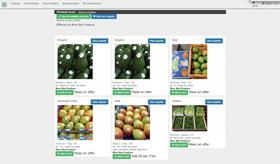
There wouldn’t be a fruit trader worth their title who hasn’t heard about e-commerce. But T-ecommerce, well, that’s a different story.
The term has been born out of the HiveXchange, a new online trading marketplace, built specifically for business–to–business (B2B) commercial trading of fresh produce.
The platform can be accessed anytime, anywhere, and uses inbuilt protocols to ensure fair, transparent and efficient trade between growers and wholesale buyers. The aim is to create an information rich, trust based environment, which forms the essence of the T-ecommerce model.
“When you buy a product online you can search a whole market, see many buyers, different price points, and come to a decision,” said Antonio Palanca, chief executive of the HiveXchange. “However, for more complex purchasing decisions you often choose to buy in person.
“When trading in person you explore options, exchange knowledge, build trust and transact. The buying journey is directed by both parties. It is private, it uses trust to manage risk, it is relationship focused. The HiveXchange takes this personal buying model and brings it into an e-commerce framework.”
Development of the HiveXchange started in February 2015, with the current platform the culmination of many prototypes and hundreds of interactions with a range of industry stakeholders.
Since its launch at the PMA A-NZ Fresh Connections event in May 2016, the platform has supported commercial volumes of trade between producers and wholesale buyers in Melbourne, Sydney and Brisbane. Over 1,000 pallets have been traded through the HiveXchange since the launch, with trade activity accelerating.
The platform does not operate as an open e-commerce marketplace, but as a trade hub for registered primary producers and registered buyers.
“As a buyer, that means you only get to see offers that are targeted at your business and ready to ship,” Palanca noted. “As a seller, you can maintain different price points for your product range, into different buyers.”
For growers, this provides elements of control and flexibility that aren’t always there with more traditional sales channels.
“It allows growers to be price makers, not takers,” explained Matthew Fealy, farm manager of Blue Sky Produce, a company that recently registered to use the HiveXchange. “You put your price in and find a buyer who is willing and able to pay that price. It creates transparency in the marketplace and its open for trade 24/7.”
In order for growers to command their desired price, the quality of their product obviously must match. This is why Fealy believes the platform will attract a certain type of producer.
“I think it will reward those who go that extra mile and put in the effort to make sure their product is top notch,” he told Fruitnet. “At the moment, there are some growers throwing their product onto the trading floor and are happy with whatever comes back. By allowing growers to set their own price, I think this platform naturally attracts those committed to higher quality and higher value.”
Along with exploring offers, buyers can also view information on the producers and exchange information with them. This information exchange is aimed at helping sustain relationships once they are established.
“One of our first clients is a primary producer in Far North Queensland,” Palanca explained. “Through the HiveXchange they targeted new wholesale buyers and chose not to make an offer to everyone in the market, rather they made offers to a handful of prospective buyers. They built new and repeat business with a buyer in Brisbane, a buyer in Sydney and a buyer in Melbourne. They have never met physically, instead, they used the HiveXchange to create a rich, entirely digital, commercial relationship.”
Nevertheless, there are provisions in place if deals don’t go as well as expected. Every trade is facilitated through a logged contract, and all notes and discussions on the order become contract addendums.
“In the event things go wrong, our contracts provide clear guidelines on how to manage issues to an acceptable resolution,” Palanca said.
In a bid to add further value to its marketbase, the HiveXchange is integrating services beyond the trade of fresh produce into its business community.
This includes the FreightExchange, a company that uses digital technology to identify empty pallet spaces in trucks travelling around Australia.
“So now a primary producer, when they are making a market offer, can get quotations and execute orders for freight logistics,” Palanca said.
Ripening and fumigation services are also being offered in Melbourne, Sydney and Brisbane, and can again be added to an order with the simple click of a button.
“This journey of building a digital ecosystem for the produce industry has only just begun,” Palanca added.
The Australian domestic market is only the starting point for the platform. The HiveXchange is working with a large logistics firm in China on the idea of supplementing T-ecommerce with an unbroken logistics supply chain from farm gates to distribution centres in the People’s Republic.
“Early trials are already underway and we expect to have our first shipment this quarter,” Palanca said. “We have a great partner organisation that we are working with in Australia who has farm interests in proteins, fruit, nuts, dried fruit and health supplements.”
From here, the HiveXchange plans to launch targeted offerings in 2017 into China, Japan and South Korea with citrus, grapes and stonefruit.
The company is recruiting wholesale buyers in these markets that can recognise quality and provenance.
“We believe that direct access to quality producers and their story, combined with short supply chains will unlock a lot of value for producers and wholesale buyers,” Palanca said. “We created and built T-ecommerce inside a technology cloud that reaches into every corner of the planet.”
A full version of this article appears inProduce Plus Summer 2016.



